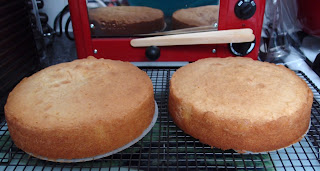
To some people, apples conjure up an Autumnal feeling. However, I saw on the BBC news this week that English apples are being picked now, in July, and it’s the earliest they’ve been harvestable for decades. It’s probably something to do with the odd sunshine-and-showers (ok, downpours) summer we’re having but I got distracted by images of lovely apples and forgot to listen to “the science bit”!
In tribute to English apples, I decided to make this traybake; however, there’s a small confession that I couldn’t find any for sale yet (I guess picking takes a while!) so have used imported Granny Smiths. I make no secret that apple is my favourite fruit to bake with – I love the flavour, the texture, and the look of it.
Cider works so well in cakes – it adds a warm, well rounded, fruitiness to any cake and doesn’t have a harsh alcoholic flavour. I used an oak matured still cider made by H. Weston & Sons based in Much Marcle, Herefordshire. They’ve been making cider since 1880 so – as you’d imagine – it was pretty good stuff! Much Marcle is a brilliant name; it sounds like it would be a kind hearted character in a Dickens novel.
Buy good cider, it really is worth the extra money, particularly when it will flavour the whole cake. Plus, this recipe only uses 150ml whereas bottles tend to be 500ml...you want something decent to polish off!
I’ve used sultanas and walnuts, but you could substitute raisins, or even dates if you wished, and I’m sure any nut would work! Apple’s so versatile that there are few other fruits or nuts it won’t compliment.
Ingredients
For the cake:
20g unsalted butter
1 ½ tablespoons golden syrup
150ml cider
250g self raising flour
½ teaspoon ground ginger
45g soft brown sugar
75g sultanas
75g walnuts, chopped
1 egg
For the topping:
1 large Granny Smith apple – or any other tart eating apple
40g unsalted butter
2 ½ tablespoons caster sugar
60g plain flour
75g walnuts, chopped
Optional: a dusting of icing sugar before serving
Thick cream
Method
Preheat the oven to 170˚C/fan oven 150˚C/325˚F/Gas mark 3.
Line a 20cm x 30cm baking tin with baking paper. I used a disposable tin traybake cases and used spray on cake release.
Start by making the cake: place the butter and golden syrup into a saucepan and melt together over a gentle heat.
Remove the pan from the heat and stir in the cider – put to one side.
In a large bowl, stir together the flour, ginger, sugar, sultanas and walnuts.
Add the golden syrup mixture along with the egg and stir until well combined.
Spoon into the prepared tin and level the surface.
Now make the topping: peel, core and chop the apple into rough chunks about 1.5 cm big.
In a saucepan (use one larger than you need just for the butter as the other ingredients will be added) melt the butter then stir in the sugar, flour, chopped apple and walnuts. It will be a dry mix.
Spread this topping over the cake batter already in the baking tin – I found this easiest to do by hand.
Level the surface then bake for approximately 30 minutes or until a skewer inserted in the cake comes out clean. Mine took exactly 30 minutes.
Leave to cool in the baking tin, on a wire rack.
A dusting of icing sugar just before serving really “pretties them up”!
Serve in generous squares with thick cream.
Bask in the glory of the wonderful thing you have made.
Eat.














































